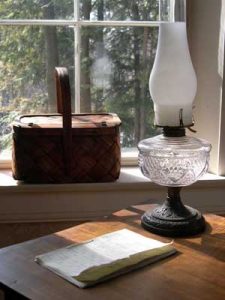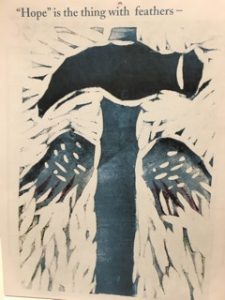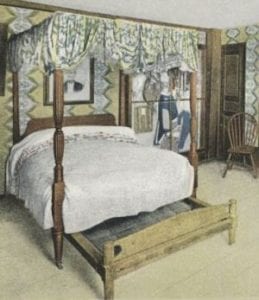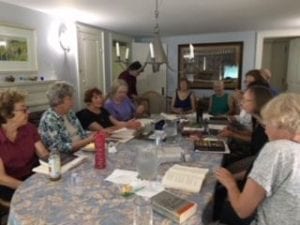On Choosing the Poems
Christine Gerhardt

Many of Dickinson’s poems – often included in her letters – revolve around avian life and imagery in ways that pay as much attention to their symbolic suggestiveness as to ornithological detail. The word “bird” appears 160 times in her 1775 poems, and specific bird names are mentioned just as frequently (robins alone come up 40 times). Some of Dickinson biographers, especially Alfred Habegger, have expressed dismay over “her too frequent bees and birds,” suggesting that after 1862 – the year of this blog – Dickinson dropped her interest in such minor life forms for “a sublime perspective that utterly changed the scale.” And yet, “bees and birds” did not precisely vanish from her later work – as “A Route of Evanescence” (F1489, J1463),“Upon his Saddle sprung a Bird” (F1663, J1600), or “The Jay his Castanette has struck” (F1670, J1635) suggest.
More importantly, bees and birds never kept Dickinson from addressing questions of cosmic proportions, or from probing deeply into some of the more controversial issues that concerned her culture at the time. Several of her bird poems celebrate creation (“At Half past Three, a single Bird” [F1099, J1084]) yet challenge established systems of faith, including one of her most famous poems, “These are the days when Birds come back” (F122, J130). Others praise the autonomous life of the mind (for instance, “Within my Garden, rides a Bird” [F 370, J500] and “To hear an Oriole sing”[F402, J526]) and contend with the time’s newly prominent scientific approaches (“Split the Lark – and you’ll find the Music –” [F905, J861]).
Still others refer to birds to unsettle seemingly straightforward regional parameters (from “The Robin’s my Criterion for Tune” [F256, J285], in which Dickinson famously professed to “see – New Englandly – ” to “A – Field of Stubble, lying sere” [F1419, J1407]). And most, if not all of her bird poems, including her twin hummingbird poems, “Within my Garden, Rides a Bird” (F370, J500) and “A Route of Evanescence” (F1489, J1463), effectively capture these elusive animals’ physiognomy, movement, and characteristic habitat in ways that rival some of the time’s most popular natural history essays.
Sources
Habegger, Alfred. My Wars are Laid away in Books. New York: Random House, 2001, 439.
“Hope” is the thing with feathers (F314A, J245)
"Hope" is the thing with
feathers –
That perches in the soul –
And sings the tune without
the words –
And never stops – at all –
And sweetest – in the Gale -
is heard –
And sore must be the storm –
That could abash the
little Bird
That kept so many warm –
I've heard it in the chillest
land –
And on the strangest Sea –
Yet – never – in Extremity,
It asked a crumb – of me.
EDA manuscript: Originally in Poems: Packet X, Mixed Fascicles, Houghton Library – (46b). Includes 14 poems, written in ink, ca. 1858-1862. Courtesy of Houghton Library, Harvard University, Cambridge, Mass. First published in Poems (1891), 27, from the fascicle (B).
Dickinson copied this poem into Fascicle 13 in the 4th place around early 1862. The editor, R. W. Franklin, notes:
There are two manuscripts, one lost that was sent to Louise and Frances Norcross, perhaps about 1862. The first line was recorded by Frances on a list of poems received (a tr43).
This is, as Sharon Leiter notes, “one of Dickinson’s most famous definition poems” in which “the poet defines an abstraction with a physical image.” However, the famous first stanza defines “Hope” as only partially physical or identifiable—a “thing with feathers.” It doesn’t become “the little Bird” until stanza two, perhaps because Dickinson knew such an image “verges perilously on sentimentality.” Or perhaps because she wanted us initially to see something more primal, less familiar than a bird, but with its aspiring means of flight.

A few contexts are important for thinking about this poem. First, Dickinson wrote two later versions of this definitional poem: “Hope is a strange invention” (F1424, J1392) in 1877 and “Hope is a subtle glutton” (F1493, J1547) in 1879 that are worth comparing with it. She clearly kept revisiting her ideas about the status of hope.
Hope is a potent word in Christian religious discourse, where, as Cynthia Wolff notes,
Christ and the “Hope” that He gave to the world [are] repeatedly figured in traditional emblems as a bird.
In this context, Leiter reminds us that during her year at Mount Holyoke Female Seminary, Dickinson was repeatedly exhorted to profess her renewed faith in Christ but remained in the group of “no-hopers.” Leiter concludes:
In this poem … Dickinson draws from the images and lexicon associated with orthodox Christianity, but reinvents them within her own vision of what is sacred.
St. Armand and Monteiro argue that a source for this poem is an emblem “available to her at the time” showing a drowning man clinging to an albatross. Other critics offer comparisons to Emily Brontë’s “Hope” (Ditsky), George Herbert’s “Hope” (Thota) and Keats’s “Ode to a Nightingale” (Vendler) in terms of the bird’s “sweetest” song “without the words.”
Let’s focus on the image of the bird, since that is our theme this week. Leiter observes that in other poems from this period about hunger, Dickinson’s speaker
is a bird among birds, sharing their crumbs and mastering the art of surviving on next to nothing. (See “Victory come Late” and “I had been hungry, all these years–”). But in this poem, the bird of Hope is something separate from the speaker, and its song and warmth are received as a form of grace, without expectation or need of reciprocity. The final lines reverberate with a sense of awe and gratitude.
Sources
Ditsky, John. “The Two Emilies and a Feathered Hope: Shared Imagery in Dickinson and Bronte.” Kyushu Amerika Bungaku [Kyusha American Literature] 19 (1978): 28-31.
Leiter, Sharon. Critical Companion to Emily Dickinson: A Literary Reference to her Life and Work. New York: Facts on File, 2007, 87-89.
St. Armand, Barton Levi and George Monteiro. “Dickinson’ ‘Hope’ is the thing with feathers.” The Explicator 47.4 (Summer 1989): 34-37.
Thota, Anand Rao. Emily Dickinson: The Metaphysical Tradition. New Dehli: Arnold-Heinemann: Atlantic Highlands: NJ: Humanities, 1982, 141-42.
Vendler, Helen. Dickinson: Selected Poems and Commentaries. Cambridge: Belknap Press of Harvard University, 2010, 118-20.
Wolff, Cynthia. Emily Dickinson. Reading, MA: Addison-Wesley Publishing Co., Inc. 1988, 478.
A Bird came down the Walk – (F359, J323)
A Bird came down
the Walk –
He did not know I
saw –
He bit an Angleworm
in halves
And ate the fellow, raw,
And then he drank
a Dew
From a Convenient Grass –
And then hopped sidewise
to the Wall
To let a Beetle pass –
He glanced with rapid
eyes
That hurried all around –
They looked like frightened
Beads, I thought –
He stirred his Velvet
Head
Like One in danger, Cautious,
I offered him a Crumb
And he unrolled his
feathers
And rowed him softer
home –
Than Oars divide the
Ocean,
Too silver for a seam –
Or Butterflies, off Banks
of Noon
Leap, plashless as they
swim.
EDA manuscript: Originally in Amherst Manuscript #fascicle 85. First published by Higginson, Atlantic Monthly, 68 (October 1891), 446-47, from the lost copy to him ([A]); Poems (1891), 140-41, from the fascicle copy (C), with the alternative not adopted. Courtesy of Amherst College, Amherst, Mass.
We discussed this poem in the February 5-11 post on Meter, focusing on how metrical form and variation enhance the narrative of the poem. It is an example of the second most frequent form in Dickinson’s canon, the short meter of quatrains of 6686 syllables rhyming abcb. Other notable poems in this form during this period are: “It would have starved a Gnat” (F444), “They shut me up in Prose”(F445), “The Heart asks Pleasure first” (F588), and “Essential Oils – are wrung –” (F772).
As we noted in the earlier post, some commentators argue that the form achieves a comic effect and provides concrete details of the natural world the poet observes closely, which they read as an allegory for the human world. The short lines, elaborated by the longer third line, combine directness with a fable-like quality. But what does this fable tell us? If we focus on the bird, the message is unsettling. The speaker wants to enter the bird’s world, even identify with him: drinking from “a dew” in “a convenient grass” suggests the scaled down perspective of a bird. But the human appearance in the bird's world is frightening, as the speaker describes in stanza 3.
Disturbance–metrical as well as thematic–occurs in the fourth stanza, whose lines contain 7676 syllables–a kind of rhythmic “crumb” thrown in the way of the reader. The crumb the speaker offers the bird echoes the crumb she never has to give in “‘Hope’ is the thing with feathers” discussed above. The extra syllable in “Cautious” alerts us to a shift in tone. That line is also an example of what Cristanne Miller calls “syntactic doubling,” a phrase that can apply logically both to the bird and the speaker. Does he accept her crumb or not and who is in danger and from what? Sharon Cameron notes that the poem
exemplifies a typical pattern of development in a good number of Dickinson’s utterances, as they linger on concrete, often trivial but entirely comprehensible phenomena, and then alter their focus in a tensile shift of the received lines into a shape that utterly perplexes them.
The bird escapes the speaker’s attempts to feed, bribe, and domestic him and she loses her chance to enter, experience, and appropriate his world. (On a Dickinson speaker’s earlier attempt to “bribe” a “little Bird” to tell the secret of nature, see “The skies cant keep their secret” [F213, J191].) In the last stanza, the extra syllable on “Ocean” signals that something special happens here as the bird’s flight is expressed in ecstatic terms of rowing in the ocean; to quote from another famous Dickinson poem about possible delirium: “Rowing in Eden – / Ah – the sea!” (“Wild Nights” [F269, J249]).
Helen Vendler, who describes this poem as “about aesthetic ecstasy obliterating the memory of savagery,” calls our attention to the wonderful “charm” and “opulence” of sounds in this last stanza: the “oh” sounds in “rolled … rowed … Home … Oars … Ocean,” followed by the sibilant s’s of “silver … seam,” and then the weightless “Butterflies, off Banks of Noon,” culminating is the near onomatopoeia of “Leap, plashless” to describe the flight of some by now allegorical winged thing. But does this gorgeous language “obliterate” or make us forget the non-human behavior of the bird? Does this behavior look like “savagery” only because it is foreign to us? Can we merely acknowledge the foreignness without trying to remedy it?
Sources
Cameron, Sharon. Lyric Time: Dickinson and the Limits of Genre. Baltimore: Johns Hopkins University Press, 1979, 6-7.
Miller, Cristanne. Emily Dickinson: A Poet’s Grammar. Cambridge: Harvard University Press, 1987, 37-39.
Vendler, Helen. Dickinson: Selected Poems and Commentaries. Cambridge: Belknap Press of Harvard University, 2010, 160.
Within my Garden, Rides a Bird (F370, J500)
Within my Garden, rides
a Bird
Opon a single Wheel –
Whose spokes a dizzy music
make
As 'twere a travelling Mill –
He never stops, but slackens
Above the Ripest Rose –
Partakes without alighting
And praises as he goes,
Till every spice is tasted –
And then his +Fairy Gig
Reels in remoter atmospheres –
And I rejoin my Dog,
And He and I, perplex us
If positive, 'twere we –
Or bore the Garden in the Brain
This Curiosity –
But He, the best Logician,
Refers my +clumsy eye –
To just vibrating Blossoms!
An exquisite Reply!
+ Microscopic Gig +duller
EDA manuscript: Originally in Poems: Packet VI, Fascicle 18. Includes 13 poems, written in ink, dated ca. 1862. Courtesy of Houghton Library, Harvard University, Cambridge, Mass. First published in Further Poems (1929), 59, with the alternative for line 18 adopted.
We discussed this poem in an earlier post on Dickinson and Gardens, where several Dartmouth students studying the “Politics of Gardens” with Professor Melissa Zeiger offered insightful readings and a range of interpretations of the bird, which they identified as a hummingbird. All of them linked the speaker’s description of the hummingbird riding a wheel with industrial mills and capitalist consumerism or energy-producing wheels, like water-wheels, grindstones, windmills, and roller machines. Scholars link this wheel to Dickinson’s pervasive use of the imagery of circumference. Yanbin Kang reads this poem along with Dickinson’s later hummingbird poem “A Route of Evanescence” (F1489, J1468, 1879) in terms of Daoist principles, re-conceptualizing circumference as a form of non-action and non-possession.
Student Zea Eanet notes that later in the poem, the speaker
describes the hummingbird as traveling within a “Fairy Gig;” in other words requiring, as human beings do, a constructed vehicle and the labor of another (a gig was traditionally pulled by a horse) for effective transportation.
Eanet goes on to identify four “characters” in the poem and ranks them in terms of their perceptive ability as presented in the poem: the garden is the highest (since the speaker wonders if the bird’s visit really even occurred); the hummingbird is next as unerringly finding the “Ripest Rose;” the narrator’s dog follows as “the best Logician;” and the narrator is last “due to her inability to understand [the hummingbird, as well as everything she perceives] as anything but analogous to appendages of human life.” Even the narrator’s use of metaphor is an “obfuscation” the reader must “decode” in order to understand the events transpiring in the garden.
Eanet concludes that this is a poem in which the speaker’s failure is our lesson:
Ultimately, the poem demonstrates how viewing the world exclusively through the lens of human experience damages our ability to perceive and to comprehend the non-human, and subsequently implies that when, and only when, we remove the anthropocentric veil that shades our eyes will we be able to engage with the rest of life with unmitigated joy.
Sources
Kang, Yanbin. “Dickinson’s Hummingbirds, Circumference, and Chinese Poetics.” The Emily Dickinson Journal 20, 2, 2011: 57-82.
A Murmur in the Trees – to note – (F433, J416)
A Murmur in the Trees – to note –
Not loud enough – for Wind –
A star – not far enough to seek –
Nor near enough – to find –
A long – long Yellow – on the Lawn –
A Hubbub – as of feet –
Not audible – as Our's – to us –
But dapperer – more sweet –
A Hurrying Home of little Men
To Houses unperceived –
All this – and more – if I should
tell –
Would never be believed –
Of Robins in the Trundle bed
How many I espy
Whose Nightgowns could not
hide the Wings –
Although I heard them try –
But then I promised ne'er
to tell –
How could I break My word?
So go your way – and I'll go
Mine –
No fear you'll miss the Road.
EDA manuscript: Originally in Poems: Packet XXXII, Mixed Fascicles, Houghton Library – (173a). Includes 12 poems, written in ink, ca. 1862. Courtesy of Houghton Library, Harvard University, Cambridge, Mass. First published in Poems (1896), 110-11.
Dickinson copied this poem into Fascicle 15 in the 11th position around autumn 1862. It is in the common meter of 8686 syllables rhyming abcb with fairly exact rhymes.
While there are almost no critical readings of this charming poem about the magic of a late spring or early summer evening in Amherst, it has lent its first line to a collection of Dickinson’s nature poems and a collection of nature drawings. Other images in the poem, especially “Robins in the Trundle bed,” according to Susan Kornfeld, appear to be very attractive to the owners of antique and boutique shops.

Kornfeld speculates that the poem captures the magic of the evening through the movement of fairies, or “little Men / To Houses unperceived,” and wonders why they are all masculine. More appropriate for our theme is the naming of “Robins” as central actors in the magical enactment. An anonymous commentator on Kornfeld’s post embraces the puzzlement the poem produces “because the poem centers on a mystery that is just at the limits of our understanding.” All of the voices on Kornfeld's post about the poem wonder about and offer various readings for the last line, asking who the “you” is and what missing or finding “the Road” means.
Another commentator points out that while the speaker of this poem seems to be in on the mystery she says she “promised ne’er to tell,” in an earlier poem, “The skies cant keep their secret!” (F213, J191), also involving a bird, the speaker perceives the secret but is outside of the mystic loop and chooses to keep it that way:
It's finer – not to know –
If Summer were an axiom –
What sorcery had snow?
Sources
Kornfeld, Susan. "A Murmur in the Trees – to note –." The prowling bee. 28 March 2013.
Of being is a bird (F462A, J653)
Of Being is a Bird
The likest to the Down
An Easy Breeze do put
afloat
The General Heavens – opon –
It soars – and shifts – and
whirls –
And measures with the Clouds
In easy – even – dazzling pace –
No different the Birds –
Except a Wake of Music
Accompany their feet –
As did the Down emit
a Tune –
For Extasy – of it
EDA manuscript: Originally in Poems: Packet XIX, Fascicle 22, Houghton Library – (105a). Includes 23 poems, written in ink, dated ca. 1862. Courtesy of Houghton Library, Harvard University, Cambridge, Mass. First published in Further Poems (1929), 20, with the alternative adopted.
Dickinson copied this poem into Fascicle 22 in the 7th position in late 1862. It is written in short meter, quatrains of 6686 rhyming abcb, like “A Bird came down the walk,” discussed above. But unlike that poem, it is not fable-like but more of a definitional poem that makes an initial comparison: “Being is a Bird.” The “Of” gives that first line the status of a philosophical meditation.
Given the context of the bird poems we have considered so far, this poem makes the most explicit bid for identifying human existence (Being) with that of a bird, or, to view it another way, perhaps it tries to understand human existence in bird terms.
The initial “breezy” tone is complicated by the word “Down,” which appears twice. Though, according to Dickinson’s Lexicon, “down” means: “Soft feathers; fine covering of baby ducks, geese and other fowl,” it is hard to miss its directional meaning, the opposite of “up.” That connotation is also captured in the associated meaning provided by the Lexicon of “Pillow; cushion; comforter; bed; resting place; … low place on the ground.”
Other words in the poem suggest a similar unsettling in their resonances: “shifts,” “dazzling” and “Wake,” a word with several possible meanings, including a vigil for the dead. In the last stanza, this cloud of connotations comes to rest in the “except” clause. It suggests that birds differ from humans in the “Wake of Music” that “Accompany their feet,” tunes they create for no other reasons than the “Extasy – of it.” This characteristic spelling suggests an out-of-body experience, a “transport” to another realm. Can wisps of “Down,” the speaker asks at the end, “emit” such seemingly irrepressible Tunes?
On September 14, I (Ivy) was privileged to present “White Heat” at a meeting of the “Dickinson Circle” in Myrifield, MA, founded and organized by scholar Margaret Freeman. In the course of our discussion, we talked about this poem and the conversation was revelatory. The group imagined the “down” as the spiritual stuff of the soul that follows it in a “wake” after death. Poet Ewa Chrusciel linked this poem with Wallace Stevens' “Of Mere Being,” a poem that also meditates on “Being” by invoking a bird—the phoenix—and ends with this gorgeous, elegiac line:
The bird's fire-fangled feathers dangle down.
You’ll know Her – by Her Foot (F604, J634)
You'll know Her – by Her Foot –
The smallest Gamboge Hand
With Fingers – where the Toes should be –
Would more affront the sand –
Than this Quaint Creature's Boot –
Adjusted by a stem –
Without a Button – I c'd vouch –
Unto a Velvet Limb –
You'll know Her – by Her Vest –
Tight fitting – Orange – Brown –
Inside a Jacket duller –
She wore when she was born –
Her Cap is small – and snug –
Constructed for the Winds –
She'd pass for Barehead – short way off –
But as she closer stands –
So finer 'tis than Wool –
You cannot feel the seam –
Nor is it clasped unto of Band –
Nor + held opon – of Brim –
You'll know Her – by Her Voice –
At first – a doubtful Tone –
A sweet endeavor – but as March
To April – hurries on –
She squanders on your +Head
Such +Threnodies of Pearl –
You beg the Robin in your Brain
To keep the other – still –
+has it any + Ear +Extasies • Revenues • Arguments
EDA manuscript: Originally in Amherst Manuscript #fascicle 84 – They called me to the window, for – asc:1472 – p. 9. Courtesy of Amherst College, Amherst, MA. First published in Bolts of Melody (1945), 64-65, with the alternatives adopted for lines 20, 25, and 26 ("Arguments").
Dickinson copied this poem into Fascicle 26 in the 16th position, around summer 1863. As one of its variants for the bird’s song is “Extasies,” it connects to the previous poem “Of Being is a bird,” and also beautifully illustrates what Christine Gerhardt calls Dickinson’s “Riddle poems,” which she identifies as
another manifestation of the ways in which Dickinson kept talking back to her time’s evolving environmental debates but enacting moments of noticing small natural phenomena that were taken for granted. … the genre’s question-answer dynamic loosely resembles the structure of scientific inquiry and includes natural history information, yet scientific visions of knowledge and control are destabilized because riddles depend on the innovative, defamiliarizing presentation of detail and play with the option of often remaining unsolved. … Second, the playful, sometimes mocking tone of her riddle poems undermines not only the sciences’ air of seriousness but also the speaker’s implied critique, as well as the sense of achievement that may come with answering the riddle’s question, thus suggesting a complex stance of humility in terms of understanding nature’s smallest creatures. And third, since riddles constitute a genre suggestive of childhood and often evoke a child’s voice, these poems reassess not conventional female perspectives but a child’s viewpoint—itself a prime sentimental interest of Victorian culture—as an environmentally resonant poetic perspective.
Indeed, the robin, whose identity is revealed at the end, is a common species, almost taken for granted, but the object of intense and detailed scrutiny by this speaker. “Gamboge” is a yellow coloring derived from a medicinal sap originally from Cambodia, but with a deadly history. The speaker personifies the bird as a well appointed woman, but , according to Gerhardt, “subverts the sentimental rhetoric” of the Victorian association of women and birds as well as the scientific obsession with classification. Though the poem “echoes the joys of imaginative control (“You’ll know Her” is repeated three times),” advanced by amateur and professional bird-watching of the time, it also “playfully destabilizes the urge to classify a bird and move on.” And the final lines, according to Gerhardt,
can be read as a comment on the challenges involved in fully fronting natural particulars that may not quite match our preconceived notions.
Sources
Gerhardt, Christine. A Place for Humility: Whitman, Dickinson, and the Natural World.
Iowa City: University of Iowa Press, 2014, 45-48.


